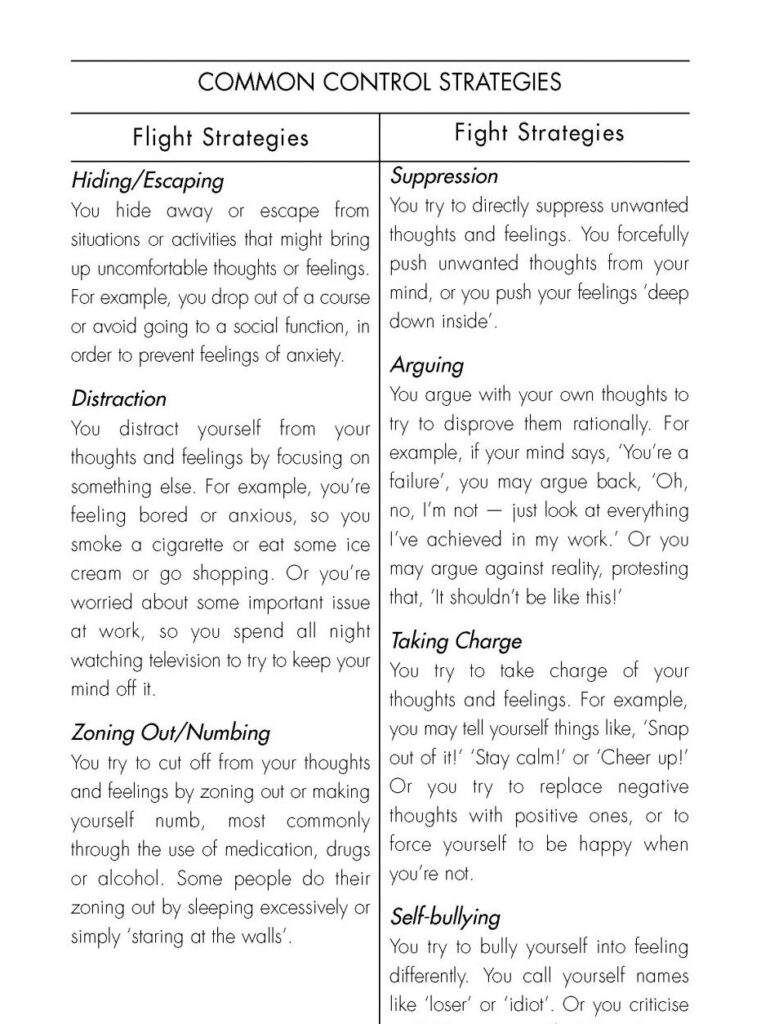Key Ideas from the book “Happiness Trap” by Dr Russ Harris
There is tremendous irony in happiness. It comes from root word meaning ‘by chance’. The irony is that people not only seek it, but they also try to hold on to it. This book is based on Acceptance and Commitment Therapy (ACT).
Here are 5 big ideas of this book:
#1: Myths about Happiness which we all believe
Myth 1: Happiness is natural state for all human beings
Happiness is a fleeting emotion that we experience in response to positive events or circumstances, and that our attempts to constantly pursue happiness can actually lead to unhappiness.
Myth 2: If you’re not happy, you’re defective
Western society assumes mental suffering as abnormal and seen as weakness, a product of mind that is somehow faulty or defective.
Myth 3: To create a better life, we must get rid of negative feelings
However, negative emotions are a natural part of the human experience, and trying to avoid them can lead to avoidance behaviors and emotional problems.
Myth 4: You should be able to control what you think and feel
Majority of self-help programs subscribe to Myth4. For eg: Many approaches teach you to identify negative feelings and replace them with positive ones, some encourage positive affirmations like “Everything that happens is for my highest good and greatest joy” and some encourage to visualise what you want. The basic theme of these approaches is to challenge your negative thoughts and instead fill your head with positive thoughts and images and you will find happiness. If only life were that simple!
Because of these myths prevalent in our society, we are in constant pursuit of happiness which actually lead to greater suffering and unhappiness and even depression.
#2: Illusion of Control
It refers to belief that we have more control over events and outcomes than we actually do.
This illusion of control can lead to feelings of anxiety, frustration, and disappointment when things don’t go according to plan, despite our efforts to control them.
Harris suggests that the illusion of control can be particularly damaging when it comes to our pursuit of happiness. We may believe that we have control over our own happiness, and that if we just try hard enough or do the right things, we will be happy all the time. However, this belief is unrealistic and can lead to a lot of unnecessary stress and suffering.
Instead, Harris recommends that we learn to accept the things we cannot control and focus on the things we can control, such as our thoughts and actions. This can involve developing mindfulness skills, learning to let go of unhelpful thoughts and beliefs, and taking actions that align with our values and goals. We can learn to appreciate the present moment and find joy in the small things, rather than constantly striving for happiness and feeling disappointed when it doesn’t materialize.
#3 Falling in Vicious Cycle:
In order to pursue Happiness, we try to get rid of, avoid or escape from unpleasant feelings which Author has called Control Strategies because they are attempts to directly control how you feel.

In order to feel happy, we try hard to control what we’re feeling. But using aforementioned control strategies have 3 significant cost:
- They take up lot of time and energy and are usually ineffective in long run. For eg: Few people when anxious feel an urge to have a chocolates or go to movies or simply go for run as their control strategy.
- We feel silly/defective/ weak minded as thoughts/feeling we’re trying to get rid of keep coming back.
- Many strategies actually lower our quality of life over the long run. For Few, anxiety might trigger an urge to have double scotch, or smoke a cigarette which could impact their health in the long run.
These unwanted outcomes lead to more unpleasant feelings, and thus even more attempts to control them. It’s a Vicious Cycle.
#4 Urge Surfing
Emotions prime your body to take action i.e. every emotion gives you impulse (URGE) to act in a certain way.
In anger, we may feel the urge to shout, smash something. In sadness, urge may make us want to lie down, cry, curl up into a ball or have someone cuddle us. Addictions typically give rise to extremely powerful urges: to gamble, get high or get drunk.
In the context of addiction or compulsive behavior, urge surfing can be used to help you cope with cravings or urges to engage in the problematic behavior. Rather than trying to fight or resist the urge, which often leads to increased tension and distress, urge surfing involves acknowledging the urge and then observing it with curiosity and non-judgmental awareness.
The Happiness Trap describes urge surfing as a way to “ride the wave” of the urge, much like a surfer rides a wave.
Whenever you find yourself having troublesome urges, there’s a basic routine you can follow.
You can remember it with acronym-OBSERVE
O=Observe: Observe your urge as if you were a curious scientist. Where do you fell it in your body? What does it feel like? Notice the associated thoughts and images and silently acknowledge the urge.
B=Breathe: means you tak a few slow, deep breaths. Breathe in to the urge.
S=SURF: treat the urge as if it were a wave that you were surfing. Notice where you feel it and how intense it is. Don’t try to rush it. Allow it to rise and fall in its sweet time.
E=EXPAND: Breathe in to the urge and make more room for it. No matter how big this urge gets, you are bigger! Allow it to be; don’t get into a fight with it. Sooner or later this urge will crest and then subside.
R=REFOCUS: means you unhook yourself from any unhelpful thoughts, and you bring your attention back to what’s happening here and now.
V=VALUES: means you take a moment to connect with what’s important in your heart- with who you want to be and what sort of life you want to create. Then you choose an effective action, one that takes your life in a valued direction.
E=ENGAGE: means you engage fully in whatever valued action you take.
#5 How do I escape the Happiness Trap?
Acceptance and Commitment Therapy (ACT) is based upon 6 core principles that work together to help you achieve 2 goals
- To effectively handle painful thoughts and feelings
- To create a rich, full and meaningful life.
These principles are:
- Cognitive Defusion: This involves learning to observe and detach from our thoughts, rather than being controlled by them. By learning to see thoughts as just thoughts, rather than as truths or commands, we can reduce the impact of unhelpful thoughts and beliefs on our emotions and behavior. To know how to apply this, you have to read the book 😉
- Acceptance: Acceptance involves learning to accept and be present with our thoughts, feelings, and experiences, rather than trying to avoid or control them. By accepting our experiences without judgment or resistance, we can reduce our suffering and increase our ability to cope with difficult situations.
- Contact with the Present Moment: This involves learning to be fully present and engaged in the present moment, rather than being caught up in worries about the past or future. By focusing our attention on the here and now, we can increase our sense of well-being and reduce our tendency to ruminate or worry.
- The Observing Self: This involves developing a sense of self-awareness and observing our thoughts, feelings, and experiences from a detached and compassionate perspective. By cultivating a sense of distance from our experiences, we can reduce our identification with our thoughts and emotions, and increase our sense of self-compassion.
- Values: Values involve identifying the things that are most important and meaningful to us, and using them as a guide for our behavior and decision-making. By living in accordance with our values, we can increase our sense of purpose and fulfillment, and reduce our tendency to be swayed by external factors such as social approval or material possessions.
- Committed Action: Committed action involves taking action that is consistent with our values and goals, even in the face of discomfort or obstacles. By taking action towards what matters most to us, we can increase our sense of autonomy and agency, and reduce our sense of helplessness or hopelessness.
These six core principles of ACT provide a framework for developing psychological flexibility, which can help us to cope with difficult emotions, overcome unhelpful patterns of thinking and behavior, and live a more meaningful and fulfilling life.
Helpful Exercises:
a) Power of 1 Deep Breath
No matter how bad the situation you’re in, no matter how much pain you may be suffering, start by taking a few deep breaths. If you’re breathing, you know you’re alive. And as long as you’re alive, there’s hope.
b) Imagine that you’re 80 years old and you’re looking back on your life as it is today. Then finish the following sentences:
- I spent too much time worrying about ….
- I spent too little time doing things such as ….
- If I could go back in time, I would…
How did it go? For many people this simple exercise is quite an eye-opener.
c) Some Suggestions by Author for waking up and experiencing the richness of the world around us.
- When you eat something, take the opportunity to savour it. Focus on the sensations in your mouth.
- Next time its raining, pay attention to sound of it: the rhythm, the pitch, the ebb and flow of volume.
- Next time its sunny, take a few moments to appreciate the warmth and the light. Go for a walk, listen to the birds and notice how the sun feels against your skin.
- When you hug or kiss someone, or even shake hands- fully engage in it. Let your warmth and openness flow through that contact.
- Next time you’re feeling happy or calm or joyful, take the opportunity to fully notice what that feels like. Take a few moments to really drink in this emotion; to marvel that you are capable of having such experiences.
- Once a day examine some familiar object that you normally take for granted such as glass of water, pen or window frame- literally anything. Study it as if it were an alien artefact that had just dropped out of a passing UFO.
- Before you get out of the bed in the morning, take 10 deep breaths and focus on the movement of your lungs. Cultivate a sense of wonder that you are alive, that your lungs have provided you with oxygen all night long, even while you were fast asleep.
- Look with new eyes at the people you care about, as if you’d never seen them before. Do this with your spouse, friends, family, co-workers. Notice how they walk, talk, eat and gesture with their faces, bodies and hands. Notice their facial expressions. Notice the way they smile: how their mouth moves, how their eyes twinkle. Notice the way they laugh: the sounds they make, the facial changes, the shoulder movements.
Enjoy these responses, be mindful of them and notice what is happening and appreciate it.
Do Read this complete book to know more about happiness and how to have more meaningful and fulfilling life. Click here to check out the book
To get the free ebook, you can drop your request in the comment section.


